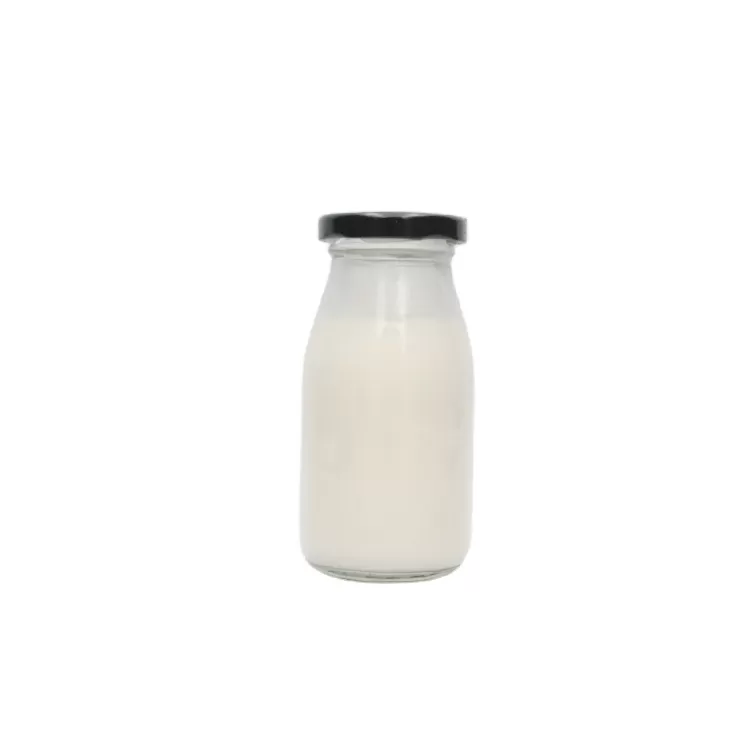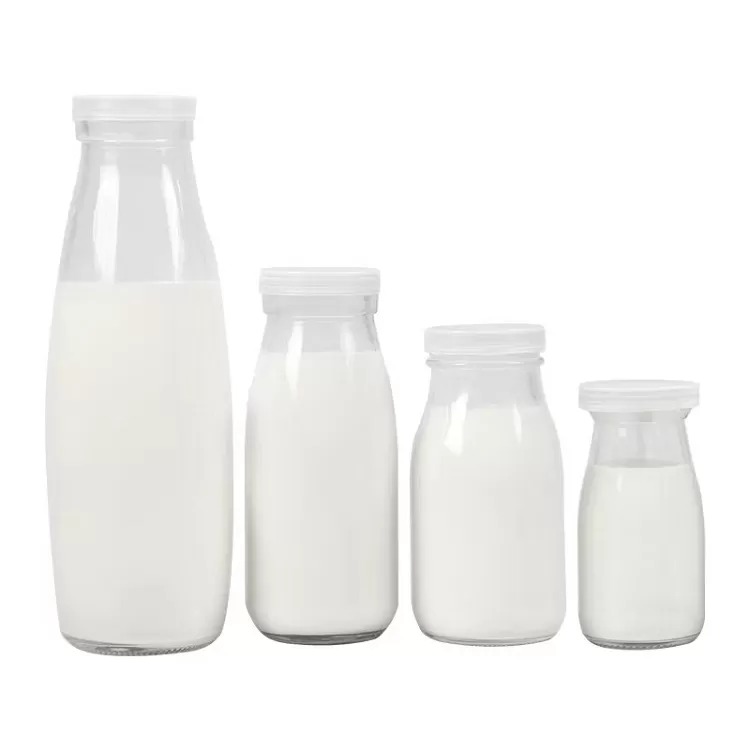The Enduring Charm of the Glass Milk Bottle: A Guide to Vintage and Modern Dairy Delivery
06-10-2025
The humble glass milk bottle is more than just a container; it's a nostalgic icon that tells a story of freshness, community, and sustainability. For many, it evokes images of the friendly neighborhood milkman, the clinking of bottles on the porch, and the creamy taste of farm-fresh milk. But beyond nostalgia, the journey of the glass milk bottle is a fascinating look into the evolution of food safety, packaging technology, and consumer habits. In this article, we'll explore the rich history of the milk bottle, from its invention to its modern-day resurgence. As a manufacturer of high-quality glass packaging for businesses worldwide, I, Allen, understand the lasting appeal and practical benefits of glass. For procurement leaders like Mark Thompson in the USA, understanding this history provides valuable insight into why glass remains a premium, safe, and sustainable choice for the dairy industry and beyond.
What Did People Use Before the First Glass Milk Bottle?
Before the standardized glass bottle became the norm, getting fresh milk was a very different experience. In urban areas during the 19th century, consumers didn't have the luxury of a refrigerator to keep dairy products fresh. Most people had to purchase milk daily. The process was often direct and unhygienic by today's standards. A common method involved a dairy farmer bringing a large metal barrel full of milk into the city on a cart.
Customers would come out of their homes with their own containers—jugs, pails, pitchers, or whatever they had available—and the farmer would use a dipper to measure out the desired amount. This practice, while providing direct access to milk, posed significant health risks. There was no protection from airborne contaminants like dust, dirt, and bacteria. The shared dipper was a perfect vehicle for spreading germs, and the quality and cleanliness of the milk were entirely dependent on the individual farmer. It was a system that desperately needed a safer, more sanitary solution. For a business owner like Mark, this history underscores the fundamental importance of sanitary, sealed packaging, a principle we still uphold today.
Who Invented the Modern Glass Milk Bottle?
The revolution in milk packaging began in the late 19th century. While several patents for milk containers were filed, the first practical and widely adopted glass milk bottle was patented in 1878 by a New York dairy owner named Harvey D. Thatcher. His invention, known as the "Thatcher's Common Sense Milk Jar," was designed to address the sanitary issues of the open-dipper system. The key innovation was its sealing mechanism—a glass lid held in place by a wire bail. This design ensured the milk was protected from contaminants from the moment it left the dairy until it reached the consumer's home.
Another significant figure in the history of milk delivery is Lewis P. Whiteman, who patented the first glass milk bottle with a cap seat in 1889. This design featured a small ledge inside the neck where a paper cap could be inserted, creating a simple yet effective seal. Shortly after, in the 1880s, Hervey Thatcher's son, Dr. Hervey D. Thatcher, a physician, improved upon the design by creating the "Thatcher's Milk Protector," which featured a waxed paper disc cap. These innovations were monumental. They not only improved public health but also built consumer trust, as the sealed bottle became a symbol of purity and safety. The clear glass also allowed customers to see the cream line, a visible mark of the milk's quality.
How Did the Milkman Delivery System Revolutionize the Dairy Industry?
The invention of the sanitary glass milk bottle paved the way for a new kind of service: home milk delivery. The iconic milkman became a staple of community life, bringing fresh milk directly to people's doorsteps. This system solved a major logistical problem for both consumers and producers. Families no longer had to rush to meet the dairy cart each morning, and dairy farms could expand their reach beyond their immediate vicinity. The milkman would typically arrive in the early morning hours, driving a milk truck filled with clinking bottles. He would collect the empty bottles left out by households and replace them with new bottles of fresh milk, often placing them in an insulated milk box on the porch to keep them cool.
This system was more than just a convenience; it was a relationship. Families knew their milkman by name, and the service was built on trust and reliability. Delivering milk door to door created a direct link between the local dairy and the community it served. The reusable nature of the glass bottles also introduced an early model of a circular economy. The bottles were washed, sterilized, and refilled at the dairy, a sustainable practice that minimized waste long before environmentalism became a mainstream concern. This reliable and personal delivery service transformed the dairy industry, making fresh, safe milk accessible to millions.

Why Was Milk Sold in Glass Bottles Instead of Other Materials?
When the shift to pre-packaged milk began, glass was the obvious choice for several compelling reasons. As a manufacturer specializing in glass, I can attest to its unique properties that make it ideal for food and beverage products.
- Purity and Inertness: Glass is non-porous and impermeable, meaning it doesn't interact with its contents. Unlike other materials, it won't leach chemicals into the milk, ensuring the taste remains pure and untainted. This is a critical factor for a delicate product like milk.
- Visibility: The transparency of glass allowed consumers to see the quality of the milk. They could check for cleanliness and, most importantly, see the cream line—the layer of cream that rises to the top. A thick cream line was a sign of rich, high-quality milk.
- Reusability and Durability: Glass bottles were built to last. They could be collected, washed, sterilized, and reused dozens of time, making them a cost-effective and environmentally friendly option for dairy farms to keep track of their inventory. Their sturdiness also protected the milk during transport and delivery.
- Hygiene: Glass can be heated to high temperatures for sterilization without degrading or releasing toxins. This ensured that every refilled bottle was perfectly clean and safe for the next customer, a crucial factor in preventing the spread of milk-borne illnesses.
Before the widespread availability of plastic and wax paper cartons, no other material could offer this combination of safety, purity, and reusability. The decision to use glass was a practical one that set a high standard for food packaging that persists to this day. When milk was sold in glass, it represented a promise of quality and safety.
What Makes Vintage Milk Bottles So Collectible?
Today, old milk bottles are cherished artifacts, sought after by collectors for their historical significance and unique charm. What makes a vintage milk bottle a piece of collectible glass? It's all in the details. Many early bottles were not plain; they were a canvas for the dairy's brand. The shape, color, and markings all tell a story.
Some of the most sought-after bottles are those made from unique colored glass, such as amber, cobalt blue, or even green glass. However, the most common distinguishing feature is the embossed or pyro-glazed (painted) label. To emboss a logo or name onto the bottle, the glass was molded with raised lettering. Later, designs and advertisements were etched onto the glass using a pyro-glazing technique, where colored paint was fired onto the bottle to create a permanent label. These labels often featured the dairy's name, location, a slogan, or a charming image like a cow or a milkmaid. The capacity, such as a quart, was also commonly embossed on the bottle. A particularly rare find is the Lester Milk Jar, a unique design that is highly valued by collectors.
How Did Dairy Farms Keep Track of Their Bottles?
The milk delivery system was a massive logistical operation, and one of the biggest challenges for a local dairy was managing its inventory of glass bottles. These bottles were a significant investment, and getting them back was crucial for the business to remain profitable. This is where the unique branding on each bottle played a vital role. The embossed or painted logos weren't just for advertising; they were a form of ownership marking.
When the milkman would fill the bottles at the dairy, they were all from the same company. But once they were delivered and collected, bottles from different dairies could easily get mixed up. By clearly marking their bottles, dairy farms could sort the returned containers and ensure they got their own stock back. Rival dairies would often cooperate to exchange misplaced bottles. This system helped maintain order and protected the assets of each local dairy farmer. The advertisements etched onto the bottles served a dual purpose: they built brand recognition on the porch and in the refrigerator, and they made it easy to identify and reclaim the valuable bottles used in the delivery services.

The Glass Bottle vs. The Milk Carton: A Classic Showdown
The dominance of the glass milk bottle began to wane with the invention of the paper milk carton. The first waxed paper cartons appeared in the early 20th century, but they gained widespread popularity after World War II. The shift was driven by several factors, primarily convenience and cost. The lightweight, single-use carton was cheaper to produce and transport, and it eliminated the need for the complex reverse logistics of collecting, washing, and sterilizing glass bottles.
However, the debate over which milk container is superior continues. From my perspective as a glass producer, while cartons have their advantages, glass maintains its edge in several key areas.
| Feature | Glass Milk Bottle | Paper/Plastic Milk Carton |
|---|---|---|
| Purity & Taste | Inert material, no chemical leaching. Keeps milk tasting fresh. | Can sometimes impart a subtle paper or plastic taste. |
| Sustainability | Infinitely recyclable and reusable. Reduces waste from landfills. | Often difficult to recycle due to mixed materials (paper, plastic, aluminum). |
| Temperature | Stays colder for longer, helping to keep milk fresher. | Less effective at maintaining a cold temperature. |
| Durability | Strong, sturdy, and protects contents well. | Prone to leaks, punctures, and crushing. |
| Cost | Higher initial cost but reusable, lowering long-term expense for dairies with a return system. | Lower initial cost but is a single-use product. |
Modern consumers are increasingly aware of the environmental impact of single-use plastics. This has led many to reconsider the benefits of glass. High-quality, durable glass containers, such as our 750ml High Boronsilicon Glass Food Bottle with Bamboo Lid, exemplify the principles of reusability and safety that made the original milk bottle so successful.
Is Home Milk Delivery Making a Comeback?
In a surprising twist, the milkman is making a comeback. A growing number of consumers are seeking out local, sustainable food sources and are willing to pay a premium for quality and convenience. This has sparked a "milkman renaissance," with local dairies and new delivery startups reviving the tradition of door to door service. Modern milk delivery services, like California's Top O' The Morn Farms or Connecticut's Echo Farms Dairy, are thriving by tapping into this demand.
The appeal is multi-faceted. First, there's the nostalgia and charm of receiving milk delivered to your doorstep. Second, it supports local agriculture and strengthens the connection between consumers and their food sources. Third, and perhaps most importantly, it's a vote for sustainability. These services almost exclusively use reusable glass milk bottles, helping customers reduce their plastic waste. The modern milkman might use an app for orders instead of a notepad, but the core principles of fresh products, reliable service, and reusable packaging remain the same. This trend shows that the values embodied by the glass milk bottle—quality, community, and environmental responsibility—are timeless.

How Can Old Milk Bottles Be Repurposed?
The sturdy nature and classic design of old milk bottles make them perfect for upcycling and creative repurposing. Instead of letting a beautiful vintage milk bottle collect dust, many people give it a new life. The simple, elegant shape of a quart bottle makes it an ideal vase for a bouquet of fresh flowers. Their clear or lightly tinted glass beautifully showcases the stems and water.
Beyond simple vases, these bottles are fantastic for home organization and decor. They can be used in the kitchen to store dry goods like grains or beans, or even as a unique dispenser for olive oil or a simple water carafe for the dinner table. In the craft room, they can hold brushes, pencils, or other supplies. For a touch of rustic charm, a collection of bottles can be used as a centerpiece or decorative accent on a shelf. Some people even create a milk bath soak and store it in a vintage bottle for a spa-like aesthetic. The possibilities are endless, proving that good design, like that found in our 100ml Pot Yogurt Milk Podding Glass Jar, never goes out of style.
What is the Future of Glass in the Dairy and Beverage Industry?
As a professional in the glass manufacturing industry, I am optimistic about the future of glass packaging. The resurgence of milk delivery is part of a larger trend toward sustainability and premiumization. Consumers, especially in markets like the USA and Europe, are increasingly rejecting single-use plastics and seeking out eco-friendly alternatives. Glass, being 100% and infinitely recyclable, is perfectly positioned to meet this demand.
For business owners like Mark, this trend represents a significant opportunity. Offering products in glass containers can elevate a brand's image, appealing to environmentally conscious consumers. In the dairy industry, we're seeing not just bottled milk, but also yogurts, creams, and specialty dairy products being milk packaged in glass. This extends to other beverages as well. The market for products like cold-brew coffee, kombucha, and premium juices in glass is expanding rapidly. For instance, a versatile container like our 500ml 16oz Square Glass Juice Bottle with Anti-theft Cover is ideal for this growing market. The future of packaging lies in materials that are safe, pure, and sustainable—and glass checks all the boxes. It has been the trusted choice for over a century, and its best days are still ahead.
Key Takeaways
- A History of Safety: The glass milk bottle was invented in the 1870s to solve the urgent public health need for a sanitary way to distribute milk, replacing the unhygienic open-dipper system.
- The Rise of the Milkman: The reusable and durable nature of glass bottles enabled the iconic milkman delivery system, which brought fresh, safe milk directly to consumers' homes.
- The Benefits of Glass: Glass was the preferred material because it is inert (doesn't affect taste), transparent (allows for quality inspection), durable, and highly sanitary.
- Collectible Charm: Vintage milk bottles are popular collectibles due to their unique shapes, colors, and embossed or painted labels that tell the story of local dairies.
- A Modern Renaissance: Today, milk delivery services are making a comeback, driven by consumer demand for local, sustainable products and a desire to reduce plastic waste.
- The Sustainable Choice: Glass remains a superior packaging material due to its infinite recyclability, reusability, and ability to keep products fresh without chemical leaching, making it a key part of a sustainable future for the food and beverage industry.








